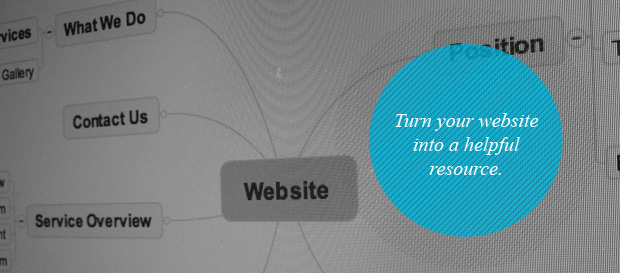Turn Your Website Into a Helpful Resource
The advice I’m about to give might seem counterintuitive, especially coming from a firm that’s so passionate about design – but if you’re planning a new website, or even a website redesign, the last thing you should focus on is the design.
Instead, ask yourself these two questions: Why will any of your customers visit your site in the first place? And why will they come back?
Far too many websites are single-serve, glorified marketing brochures that might be updated every quarter. Customers visit the sites, find the information they need, fill out a contact form and leave, never to return again.
The ultimate goal for your new website is for it to become a trusted resource, helping members of your audience do their jobs better. This can only happen when your site is focused on solving customers’ problems, and not just on selling products. Selling should be secondary.
Think of the websites you visit regularly. Most likely, the reason you come back time and time again is because the site has updated content you are interested in. It helps you do what you do, only better. It becomes a resource instead of a sales pitch.
And yes, when you’re ready to buy, I bet you’ll think of them first.
So how do you make your website more valuable to your audience? It sounds simple, but the first thing you have to do is define who your audience is. Then, you need to identify their challenges. Try to think of the three biggest problems you can help them solve. And then, do it: give them clear paths to action toward your white papers, email newsletters and webinars.
Once again, you should help first and sell second.
Of course, there are other benefits in creating a helpful resource for your customers and prospect. On today’s Internet, when people find something they like or find useful, they share it with other professionals (and you should build-in the tools for them to do so easily). If they’re in the throes of a purchasing decision, a website that offers the products they need, alongside evidence of a thorough understanding of their challenges, provides a much more rounded, and therefore more persuasive, sales message.
Search Engine Optimization, or SEO, becomes a side effect, albeit a powerful one. All of this relevant content makes it easier for Google to find you. And, as you know from experience, when people search, they ask Google questions. When you focus your content on answering these questions and solving the problems real people face, Google will love you.
So take it from a writer at a design-focused firm: Yes, your website should be a well-designed, beautifully executed expression of your brand. But the real key is to put content out in front – content that connects with your audience, showcases your expertise and keeps your customers coming back for more.
 Rich Heend is a senior copywriter for Atomicdust, helping us develop engaging websites, print materials and, as you can see, the occasional blog post. Basically, he reads and rights writes for us. (Oh, and he edits too.)
Rich Heend is a senior copywriter for Atomicdust, helping us develop engaging websites, print materials and, as you can see, the occasional blog post. Basically, he reads and rights writes for us. (Oh, and he edits too.)


